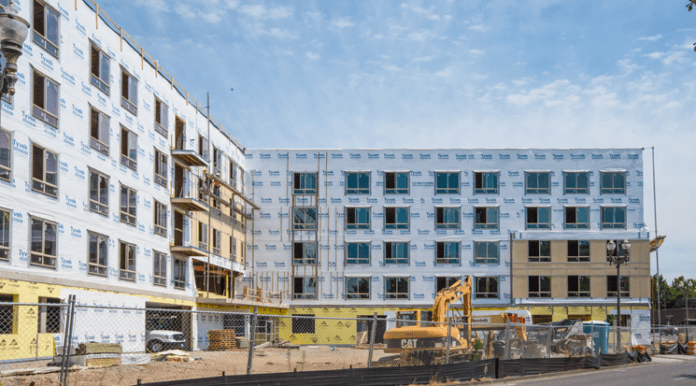By the end of June, Southwest Washington had become part of the 20 percent of the continental U.S. being classified by NOAA (National Oceanic and Atmospheric Administration) as experiencing moderate to extreme drought conditions. However, for at least one industry that lack of precipitation has an upside.
Dry weather, in combination with a more robust economy, has set the perfect stage for Clark County’s building sector to exceed expectations. According to Troy Johns, owner of Urban Northwest Homes, it couldn’t come soon enough.
“Any time saved right now – we have such a shortage of housing – any housing stock that we can get out there, that will level out housing prices and rental prices, is a good thing. We just have to have more stock. There’s not enough,” said Johns.
The construction industry factors in down time for rain from February to July, but with so little moisture in the first half of 2015, companies have been able to keep plugging along in large part due to less time spent on stormwater issues.
From single-family to industrial-sized sites, entire crews are required to control erosion and sediment, stabilize soil, protect slopes and drain inlets and a host of other stormwater pollution factors as well as periodic inspections to make sure the site continues to meet or exceed standards. Instead, smaller crews are being utilized for an opposite issue; dust control.
Another significant time-saving element is drying out the interior of each home built in wet conditions, which can take up to two weeks. According to Johns, the cost of this process is a few hundred dollars per home, but the lost time per job can range from $1,200-$1,500. If one builder is responsible for 100 homes, that savings in time and money is substantial.
High demand has also allowed builders to tap into the cost-savings avenue of reducing or doing away with advertising. Johns and Ott Gaither, president of Gaither & Sons Construction, both reported that their advertising budget is currently word-of-mouth as opposed to paid sources like Zillow.
Before anyone wonders why that savings isn’t being passed on to the consumer, there’s another factor to consider. Trades suffered a shrinking labor force as a result of the 2008 economic downturn that hasn’t bounced back as quickly as home demands, leaving fewer skilled laborers who are now commanding a higher price for their services. However, Gaither sees this as a self-regulating phenomenon.
“The gap is slowly being filled and labor challenges will be met here as more people enter the marketplace in the coming months… the labor force will balance back out here in the next year or so, in my opinion,” he said.
There are negative construction factors to be aware of with the extended dry period in Southwest Washington. Aside from switching gears from erosion control to dust management, Gaither pointed out that landscaping businesses are heavily affected as the mortality rate of plants and lawns goes up along with maintenance costs to keep them alive. Risk of dehydration and heat stroke among workers are very real concerns during long spans of 90+ degree days, prompting workers to drink a gallon or more of water as the mercury rises.
Even taking unfavorable factors into consideration, Johns views the extended dry spell as an overall positive in tandem with a better market.
“We all pray for a nice dry summer so we can get our projects done before the winter so this is a blessing for sure,” he said.
Johns added that the biggest surprise for him right now is the mental shift of buyers. When banks tightened lending guidelines after the 2008 housing market crash, requiring larger down payments, Johns was sure prospective homeowners wouldn’t be able to foot the bill. But he recently worked with a 25 year-old who came in with nearly $13,000 that he’d saved up over the last few years and that appears to be the new normal.
While single and multi-family home construction is seeing drier days translate to quicker turnaround times, larger scale projects feel the effects of the weather far less. Skanska USA Building has been responsible for upwards of $150 million in Southwest Washington project values over the last three to four years including Woodland High School (which should be turned over in time to occupy the upcoming school year), Banfield Pet Hospital’s corporate headquarters in East County and the STEM building at Clark College’s main campus.
Jim Link, Skanska’s executive vice president and general manager for Oregon and Southwest Washington, explained that the scope of each worksite, by default, translates to the foundation being poured, the roof being installed – or both – in the rain.
He did agree that, overall, construction labor costs have increased.
“I think labor pressure – the availability of labor and the availability of suppliers and sub-contractors – is stressed by the overall demand,” Lind said. “[The] market has pivoted hard in the last 36 months. [We’re experiencing] general economic growth and certainly capital has been freed up to drive economic growth.”
Gaither added that in general, the market is experiencing a rebound and it’s his hope and the hope of his colleagues that it’s not a boom and bust cycle, and that everyone benefits.




